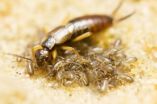(Press-News.org) Washington, DC – Researchers, including a team from Children's National Health System, have identified head circumference and head tilting reflex as two reliable biomarkers in the identification of autism spectrum disorders (ASD) in children that are between 9 and 12 months of age.
According to the U.S. Centers for Disease Control and Prevention, ASD is identifiable as early as two years old, although most children are not identified until after the age of four. While a number of studies have reported that parents of children with ASD notice developmental problems in children before their first birthday, there has yet to be a screening tool to identify those children.
"While the 'gold standard' screening tool is the M-CHAT questionnaire, it must be read and completed by parents and then interpreted by a health care provider," said lead author Carole A. Samango-Sprouse, EdD, and Associate Clinical Professor of Pediatrics at the George Washington University School of Medicine and Health Sciences. "What physicians are missing is a quick and effective screening measure that can easily be given to all infants regardless of background and identify ASD before 12 months. This screening is also helpful in identifying those babies who may not initially appear to be at risk and would otherwise be missed until much later in life."
This study looked at the use of head circumference and head tilting reflex as two biomarkers that can be used during their well-baby visits by their primary care providers. Both screenings were given to nearly 1,000 patients at the four, six, and nine-month well-baby visits.
At the end of nine months, those infants with a head circumference above or equal to the 75th percentile, a head circumference that was in 10 percent discrepancy with the height of the baby, or those who failed the head tilting reflex test were considered at risk for ASD or a developmental language delay. These infants were then evaluated by a neurodevelomental specialist and pediatric neurologist to differentiate between these disorders.
Of the 49 infants that displayed abnormal results, without previous diagnosis, 15 were identified at risk for ASD and 34 at risk for developmental language delay. Of the 15 children who were identified at risk for ASD between 9 and 12 months of age, 14 (93 percent) sustained the diagnosis when it was made clinically at the age of three.
"We will continue looking at the efficacy of the head circumference and head tilting reflex as a screening tool for these disorders," said Andrea Gropman, MD, a contributor to the study and Division Chief of Neurogenetics at Children's National. "As with all developmental delays, especially ASD, the sooner we can identify those children who are at risk, the sooner we can intervene and provide appropriate treatment. In other words, the sooner we identify these delays, the better the outcome for those affected."
INFORMATION:
Contact: Emily Hartman or Caitlyn Camacho at 202-476-4500.
Related Links
Center for Autism Spectrum Disorders at Children's National
Genetics program at Children's National
About Children's National Health System
Children's National Health System, based in Washington, DC, has been serving the nation's children since 1870. Children's National's hospital is Magnet® designated, and is consistently ranked among the top pediatric hospitals by U.S.News & World Report. Home to the Children's Research Institute and the Sheikh Zayed Institute for Pediatric Surgical Innovation, Children's National is one of the nation's top NIH-funded pediatric institutions. With a community-based pediatric network, eight regional outpatient centers, an ambulatory surgery center, two emergency rooms, an acute care hospital, and collaborations throughout the region, Children's National is recognized for its expertise and innovation in pediatric care and as an advocate for all children. For more information, visit ChildrensNational.org, or follow us on Facebook and Twitter.
New method of screening children for autism spectrum disorders works at 9 months old
Two biomarkers could help predict autism spectrum disorders and other developmental delays
2014-04-15
ELSE PRESS RELEASES FROM THIS DATE:
Low-calorie restaurant menus: Are they making us fat?
2014-04-15
Depending on our food cravings, the number of items served, and even the time of day, ordering a meal at a restaurant often requires a "narrowing down" decision making process. According to a new study in the Journal of Consumer Research, restaurants that now provide "low-calorie" labels on their menus can inadvertently cause people to eliminate healthy foods right off the bat.
"Because most restaurant menus are quite complex—offering numerous dishes composed of multiple ingredients—diners try to simplify their decision. People have come to expect low-calorie food to ...
More should be done for female parolees
2014-04-15
EAST LANSING, Mich. --- As the female prison population grows, a new study funded partly by the National Science Foundation says more should be done to help women probationers and parolees in poor urban areas remain crime-free.
A team of Michigan State University criminologists found black women on probation and parole feel they have little choice but to isolate themselves in their homes or risk getting caught up in the type of criminal activity that got them in trouble in the first place.
Probation and parole officers, case managers and others should help the women ...
When identity marketing backfires: Consumers don't like to be told what they like
2014-04-15
When choosy moms choose Jif peanut butter and sports fans who call themselves sports fans subscribe to DirecTV, identity marketing is hard at work. But what happens when this type of advertising misses the mark? According to a new study in the Journal of Consumer Research, when a person's sense of ownership and freedom is threatened they are less likely to respond positively to identity marketing campaigns.
"While people may be drawn to brands that fit their identity, they are also more likely to desire a sense of ownership and freedom in how they express that identity. ...
Sibling cooperation in earwig families gives clues to early evolution of social behavior
2014-04-15
Looking at the question of how social behavior has developed over the course of evolution, scientists from the universities in Mainz and Basel have gained new insights from the study of earwigs. "Young earwig offspring don't simply compete for food. Rather the siblings share what is available amongst themselves, especially when the mother is absent," explained Dr. Joël Meunier of the Evolutionary Biology section of the Institute of Zoology at Johannes Gutenberg University of Mainz (JGU). The team of biologists from Mainz University and the University of Basel investigated ...
Charitable donation discrepancies: Why are some countries more generous than others?
2014-04-15
When it comes to charitable giving, some countries open their collective wallets more than others. According to a new study in the Journal of Consumer Research, people who live in countries that promote equality in power and wealth are more likely to donate money than those who live in societies that expect and accept inequality.
"Our research examines whether cultural values can explain the different levels of charitable giving between different countries," write authors Karen Page Winterich (Pennsylvania State University) and Yinlong Zhang (University of Texas, San ...
Chew on this: How does food texture impact its perceived calorie content?
2014-04-15
Food is an intimately personal thing; we savor some tastes and despise others. But how does the way we chew and eat our food impact our overall consumption? According to a new study in the Journal of Consumer Research, people perceive foods that are either hard or have a rough texture to have fewer calories.
"We studied the link between how a food feels in your mouth and the amount we eat, the types of food we choose, and how many calories we think we are consuming," write authors Dipayan Biswas, Courtney Szocs (both University of South Florida), Aradhna Krishna (University ...
Consumer predictions: Do categories matter when predicting the lottery or stock market?
2014-04-15
From sports to the stock market and even winning the lottery, it's in our nature to predict who or what will come out on top. But, sometimes we can't see the forest for the trees. According to a new study in the Journal of Consumer Research, people are more likely to make a prediction about something when it is grouped in a large category of similar items.
"One factor that can contribute to a person's flawed judgment is categorization," write authors Mathew S. Isaac (Seattle University) and Aaron R. Brough (Utah State University). "When making a prediction, we can become ...
Can refined categorization improve prediction of patient survival in RECIST 1.1
2014-04-15
In a recent analysis by the RECIST Working Group published in the European Journal of Cancer, EORTC researchers had explored whether a more refined categorization of tumor response or various aspects of progression could improve prediction of overall survival in the RECIST database. They found that modeling target lesion tumor growth did not improve the prediction of overall survival above and beyond that of the other components of progression. The RECIST Working Group includes the EORTC, the United States National Cancer Institute, and the National Cancer Institute of ...
New method isolates immune cells for researchers to study how they ward off oral diseases
2014-04-15
Case Western Reserve University dental researchers have found a less invasive way to extract single rare immune cells from the mouth to study how the mouth's natural defenses ward off infection and inflammation.
By isolating some specialized immune cells (white blood cells known as "leukocytes") to study how they fight diseases in the mouth—or reject foreign tissues, such as in failed organ transplants—researchers hope to learn more about treating and preventing such health issues as oral cancers, cardiovascular disease, AIDS and other infectious diseases.
To this point, ...
Study: Deforestation could intensify climate change in Congo Basin by half
2014-04-15
By 2050, deforestation could cause temperatures in the Congo Basin to increase by 0.7 °C. The increase would intensify warming caused by greenhouse gases by half, according to a study by researchers at the University of Leuven, Belgium.
Explosive population growth and inefficient agricultural practices are causing large-scale destruction of tropical rainforests in Central Africa. A team of researchers from the University of Leuven examined how these practices will affect longer-term temperatures in the region. Using a sophisticated computer model, they forecasted Congo ...
LAST 30 PRESS RELEASES:
SIMJ announces global collaborative book project in commemoration of its 75th anniversary
Air pollution exposure and birth weight
Obstructive sleep apnea risk and mental health conditions among older adults
How talking slows eye movements behind the wheel
The Ceramic Society of Japan’s Oxoate Ceramics Research Association launches new international book project
Heart-brain connection: international study reveals the role of the vagus nerve in keeping the heart young
Researchers identify Rb1 as a predictive biomarker for a new therapeutic strategy in some breast cancers
Survey reveals ethical gaps slowing AI adoption in pediatric surgery
Stimulant ADHD medications work differently than thought
AI overestimates how smart people are, according to HSE economists
HSE researchers create genome-wide map of quadruplexes
Scientists boost cell "powerhouses" to burn more calories
Automatic label checking: The missing step in making reliable medical AI
Low daily alcohol intake linked to 50% heightened mouth cancer risk in India
American Meteorological Society announces Rick Spinrad as 2026 President-Elect
Biomass-based carbon capture spotlighted in newly released global climate webinar recording
Illuminating invisible nano pollutants: advanced bioimaging tracks the full journey of emerging nanoscale contaminants in living systems
How does age affect recovery from spinal cord injury?
Novel AI tool offers prognosis for patients with head and neck cancer
Fathers’ microplastic exposure tied to their children’s metabolic problems
Research validates laboratory model for studying high-grade serous ovarian cancer
SIR 2026 delivers transformative breakthroughs in minimally invasive medicine to improve patient care
Stem Cell Reports most downloaded papers of 2025 highlight the breadth and impact of stem cell research
Oxford-led study estimates NHS spends around 3% of its primary and secondary care budget on the health impacts of heat and cold in England
A researcher’s long quest leads to a smart composite breakthrough
Urban wild bees act as “microbial sensors” of city health.
New study finds where you live affects recovery after a hip fracture
Forecasting the impact of fully automated vehicle adoption on US road traffic injuries
Alcohol-related hospitalizations from 2016 to 2022
Semaglutide and hospitalizations in patients with obesity and established cardiovascular disease
[Press-News.org] New method of screening children for autism spectrum disorders works at 9 months oldTwo biomarkers could help predict autism spectrum disorders and other developmental delays


